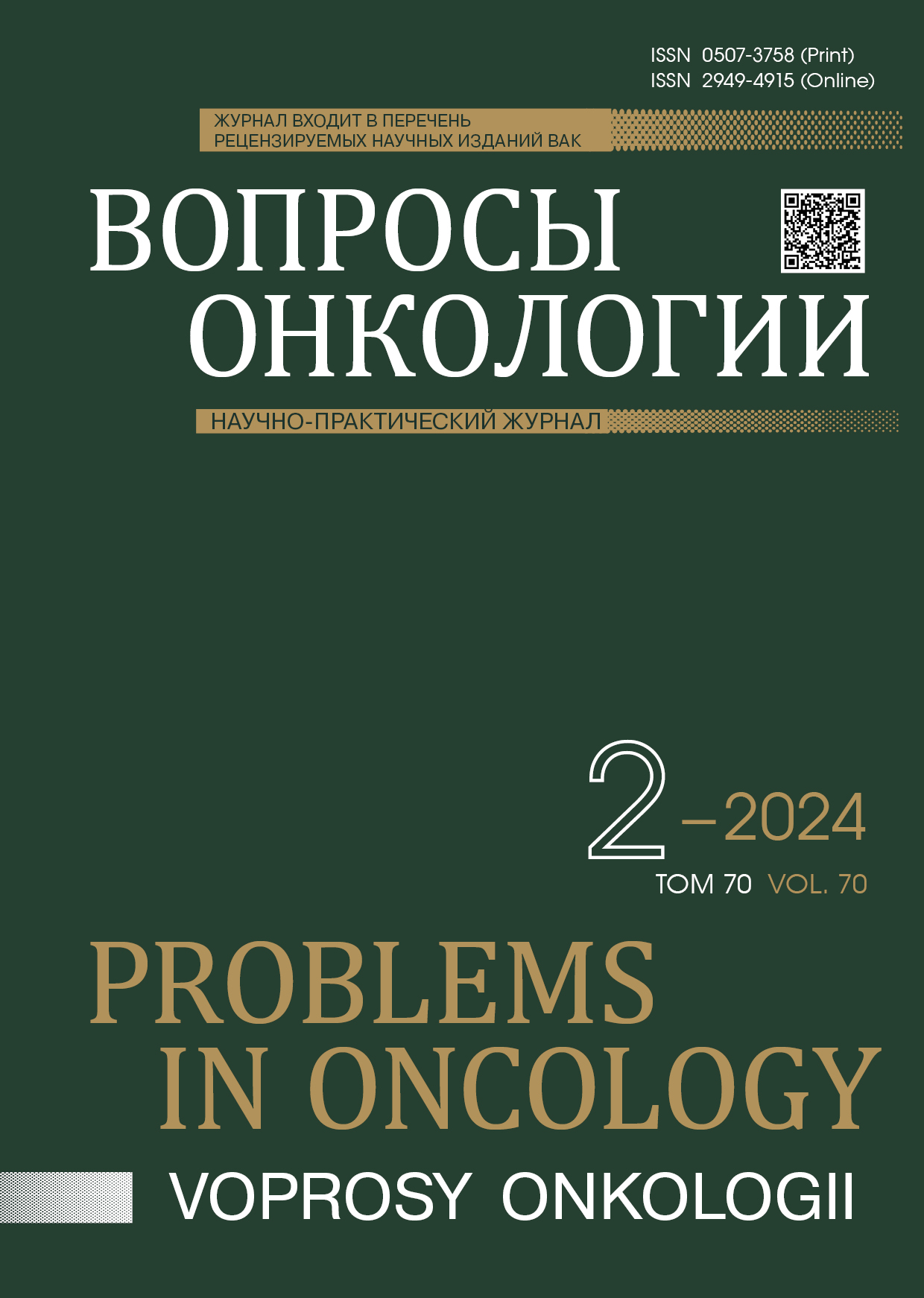Аннотация
Цель. Оценить эффективность и безопасность стереотаксической лучевой терапии (СТЛТ) рака предстательной железы в группах низкого и промежуточного риска прогрессирования (НПРП).
Материалы и методы. С апреля 2014 г. по июнь 2018 г. СТЛТ использовалась в качестве метода монотерапии у 111 первичных больных раком предстательной железы НПРП. СТЛТ проводилась в режиме 5 фракций по 7,25 Гр по стандартной технологии: после установки 2-3 маркеров, выполнения топометрических исследований на магнитно-резонансном и рентгеновском компьютерном (КТ) томографах и планирования на системе Eclipse с применением техники объемно-модулированной лучевой терапии арками (ОМЛТ). Оценивалась пятилетняя выживаемость без признаков биохимического рецидива (ВБПБР) в соответствии с критериями биохимического рецидива «Phoenix definition». Токсичность оценивалась в соответствии с критериями RTOG и CTAE.
Результаты. Медиана наблюдения составила 78 (60-110) мес. 5-летняя ВБПБР для обеих групп составила 91 %: 95,5 % для низкого риска и 88,2 % для пациентов из группы промежуточного риска прогрессирования. Локальный контроль был достигнут у 97,3 % больных. Поздние осложнения со стороны мочевыводящих путей соответствующие II степени отмечались в 11 случаях (10 %), III степени — в 1 случае (0,9 %). Токсичность со стороны прямой кишки II степени была отмечена у 6 пациентов (5,4 %), III степени — не наблюдалась.
Выводы. Результаты 5-летнего наблюдения после СТЛТ у больных РПЖ НПРР доказали высокую эффективность и безопасность метода, что позволяет рекомендовать его для широкого клинического использования.
Библиографические ссылки
Lennernäs B., Majumder K., Damber J., et al. Radical prostatectomy versus high-dose irradiation in localized/locally advanced prostate cancer: A Swedish multicenter randomized trial with patient-reported outcomes. Acta Oncol. 2015; 54(6): 875-81.-DOI: https://doi.org/10.3109/0284186X.2014.974827.
Hamdy F., Donovan J., Lane J., et al. Protect Study Group. 10-Year Outcomes after Monitoring, Surgery, or Radiotherapy for Localized Prostate Cancer. N Engl J Med. 2016; 375(15): 1415-1424.-DOI: https://doi.org/10.1056/NEJMoa1606220.
Neal D.E., Metcalfe C., Donovan J.L., et al. Ten-year mortality, disease progression, and treatment-related side effects in men with localised prostate cancer from the protect randomised controlled trial according to treatment received. Eur Urol. 2020;77(3): 320-330.-DOI: https://doi.org/10.1016/j.eururo.2019.10.030.
Гафтон Г.И., Новиков Р.В, Новиков С.Н., et al. Брахитерапия рака предстательной железы источником высокой мощности дозы в режиме монотерапии: анализ пятилетних результатов. Вопросы онкологии. 2020; 66(6): 685-694.-DOI: https://doi.org/10.37469/0507-3758-2020-66-4-404-412.
[Gafton G.I., Novikov R.V., Novikov S.N., et al. Brachytherapy of prostate cancer with a high dose rate source in monotherapy mode: an analysis of five-year results. Voprosy Onkologii = Problems in Oncology. 2020; 66(6): 685-694.-DOI: https://doi.org/10.37469/0507-3758-2020-66-4-404-412. (In Rus)].
Новиков С.Н., Канаев С.В., Новиков Р.В., и др Клинический опыт использования брахитерапии источниками высокой мощности дозы для монотерапии больных раком предстательной железы. Вопросы онкологии. 2018; 64(3): 366-373.-DOI: https://doi.org/10.37469/0507-3758-2018-64-3-366-373.
[Novikov S.N., Kanaev S.V., Novikov R.V., et al. Clinical experience of using brachytherapy with high dose rate sources for monotherapy of prostate cancer patients. Voprosy Onkologii = Problems in Oncology. 2018; 64(3): 366-373.-DOI: https://doi.org/.37469/0507-3758-2018-64-3-366-373. (In Rus)].
Behmueller M., Tselis N., Zamboglou N., et al. High-dose-rate brachytherapy as monotherapy for low- and intermediate-risk prostate cancer. Oncological outcomes after a median 15-year follow-up. Front Oncol. 2021;11:770959.-DOI: https://doi.org/10.3389/fonc.2021.770959.
Viani G.A., Arruda C.V., Pellizzon A.C.A., et al. HDR brachytherapy as monotherapy for prostate cancer: A systematic review with meta-analysis. Brachytherapy. 2021; 20: 307-314.-DOI: https://doi.org/10.1016/j.brachy.2020.10.009.
Royce T.J., Wang K., Sheets N.C., et al. Tumor control probability modeling and systematic review of the literature of stereotactic body radiation therapy for prostate cancer. Int J Radiation Oncol Biol Phys. 2021; 110(1): 227-236.-DOI: https://doi.org/10.1016 /j.ijrobp.2020.08.014.
Brand D.H., Tree A.C., Ostler P., et al. Intensity-modulated fractionated radiotherapy versus stereotactic body radiotherapy for prostate cancer (PACE-B): acute toxicity findings from an international, randomised, open-label, phase 3, non-inferiority trial. Lancet Oncol. 2019; 20: 1531-43.-DOI: https://doi.org/10.1016/S1470-2045(19)30569-8.
Fransson P., Nilsson P., Gunnlaugsson A., et al. Ultra-Hypofractionated versus conventionally fractionated radiotherapy for prostate cancer (HYPO-RT-PC): patient-reported quality-of-life outcomes of a randomised, controlled, non-inferiority, phase 3 trial. Lancet Oncol. 2021.-DOI: https://doi.org/10.1016/S1470-2045(20)30581-7.
Ильин Н.Д., Мельник Ю.С., Новиков С.Н., и др. Влияние интрафракционных смещений при проведении стереотаксической лучевой терапии рака предстательной железы на финальное распределение дозы. Вопросы онкологии. 2022; 68(2): 215-223.-DOI: https://doi.org/10.37469/0507-3758-2022-68-2-215-223.
[Ilyin N.D., Melnik Y.S., Novikov S.N. et al. Influence of intrafractional displacements during stereotactic radiotherapy of prostate cancer on the final dose distribution. Voprosy Onkologii = Problems in Oncology. 2022; 68(2): 215-223.-DOI: https://doi.org/10.37469/0507-3758-2022-68-2-215-223. (In Rus)].
Канаев С.В., Новиков С.Н., Новиков Р.В., и др. Методология стереотаксической лучевой терапии рака предстательной железы. Вопросы онкологии. 2017; 63(2): 287-293.-DOI: https://doi.org/10.37469/0507-3758-2017-63-2-287-293.
[Kanaev S.V., Novikov S.N., Novikov R.V. et al. Methodology of stereotactic radiotherapy of prostate cancer. Voprosy Onkologii = Problems in Oncology. 2017; 63(2): 287-293.-DOI: https://doi.org/10.37469/0507-3758-2017-63-2-287-293. (In Rus)].
Schaeffer E.M., Srinivas S., Adra N., et al. NCCN Guidelines® Insights: Prostate Cancer, Version 1.2023. J Natl Compr Canc Netw. 2022; 20(12): 1288-1298.-DOI: https://doi.org/10.6004/jnccn.2022.0063.
US Department of Health and Human Services, National Institutes of Health, National Cancer Institute. Common Terminology Criteria for Adverse Events (CTCAE), version 4.03. 2010; 80. URL: https://evs.nci.nih.gov/ftp1/CTCAE/CTCAE_4.03/CTCAE_4.03_2010-06-14_QuickReference_8.5x11.pdf.
Freeman D., Dickerson G., Perman M. Multi-institutional registry for prostate cancer radiosurgery: a prospective observational clinical trial. Front Oncol. 2015; 4: 369.-DOI: https://doi.org/10.3389/fonc.2014.00369.
Widmark A., Gunnlaugsson A., Beckman L., et al. Ultra-hypofractionated versus conventionally fractionated radiotherapy for prostate cancer: 5-year outcomes of the HYPO-RT-PC randomised, non-inferiority, phase 3 trial. Lancet. 2019; 394(10196): 385-395.-DOI: https://doi.org/10.1016/S0140-6736(19)31131-6.
Meier R.M., Bloch D.A., Cotrutz C., et al. Multicenter trial of stereotactic body radiation therapy for low- and intermediate-risk prostate cancer: survival and toxicity endpoints. Int J Radiat Oncol Biol Phys. 2018; 102(2): 296-303.-DOI: https://doi.org/10.1016/j.ijrobp.2018.05.040.
Andrzejewski P., Kuess P., Knausl B., et al. Feasibility of dominant intraprostatic lesion boosting using advanced photon-, proton- or brachytherapy. Radiother Oncol. 2015; 117(3): 509-514.-DOI: https://doi.org/10.1016/j.radonc.2015.07.028.
Frohlich G., Agoston P., Jorgo K., et al. Comparative dosimetrical analysis of intensity-modulated arc therapy, CyberKnife therapy and image-guided interstitial HDR and LDR brachytherapy of low risk prostate cancer. Reports of Practical Oncology and Radiotherapy. 2021; 26(2): 196-202.-DOI: https://doi.org/10.5603/RPOR.a2021.0028.
Novikov S.N., Kanaev S.V., Novikov R.V., et al. Template guided transperineal saturation biopsy of the prostate: lessons for focal and urethra-sparing high-dose-rate brachytherapy for localized prostate cancer. J Contemp Brachytherapy. 2016; 8(2): 110-115.-DOI: https://doi.org/10.5114/jcb.2016.59336.

Это произведение доступно по лицензии Creative Commons «Attribution-NonCommercial-NoDerivatives» («Атрибуция — Некоммерческое использование — Без производных произведений») 4.0 Всемирная.
© АННМО «Вопросы онкологии», Copyright (c) 2024

